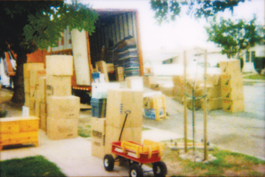home | metro santa cruz index | the arts | visual arts | review

Photograph by Norman Locks
Out of the Box 'Moving from San Diego' and other pieces by Norman Locks, as well as works by fellow UCSC professor Lewis Watts, show at the Felix Kulpa Gallery starting Friday.
'Chronotopographies' at the Felix Kulpa Gallery
Digital photography by UCSC profs Lewis Watts and Norman Locks
By Jean Stirling
Chronotopographies: remembering in digital" is an exhibition opening Friday at the Felix Kulpa Gallery and organized by Jake Thomas, who was a recent student of two influential artist-professors at UCSC, Lewis Watts and Norman Locks. Both artists were deeply immersed in the analog photography world, where each earned significant recognition, but each has pursued ideas that he has only been able to fully realize as he embraced digital technology. This exhibition of artwork created with digital technology, which is essentially available to everyone, makes it clear that technique and technology are only tools for what is still the defining property of great art: great ideas.
Lewis Watts taught at UC-Berkeley for 27 years before coming to UCSC about six years ago. His academic career began in political science and history, then meandered to achitecture and finally design and photography.
All these interests are present in his photographic exploration of the genealogy of family, culture, race and social migration, expressed as "cultural landscape."
"Both my parents are from the South and I was born in Arkansas. When my father was discharged from the military after the war he pursued the jobs available in Seattle, and that's were we lived and where I grew up," says Watts.
Such a migration of African American families from South to North after World War II was a common pattern that created new communities with deep Southern roots throughout the urban north. Within an archive of Watts' photographs, the big idea of his work becomes clear. Here is a Richmond garden circled by plastic milk bottles, a practice of the South that has roots in Africa. Storefront churches bespeak a community where miracles are expected.
"I started to photograph West Oakland, where there was a lot of evidence on the street that the community came from the same background as my parents," Watts says.
Felix Kulpa shows work that arose from his book published last year, Harlem of the West: The San Francisco Fillmore Jazz Era. The extraordinary collection of images of Billie Holliday have been digitally gathered and sequenced into a work that will be revealed at the exhibition.
Norman Locks, meanwhile, trains his camera on the everyday to unique effect. "I was raised in abstract expressionism," he says—first, in a family of artists and art educators and later at the San Francisco Art Institute. After graduate school he he spent four years directing workshops for Ansel Adams before coming to UCSC, where he has taught for 30 years.
Despite such lineage and upbringing, Locks was never locked in the ivory tower of academia. "My wife and I had a son when I was 20; education and work and questions of art overlapped always with the responsibilities of family," he says.
One of the bodies of Locks' work in the show—which is entirely digital—is derived from tiny images captured by a crude Polaroid I-zone camera, then digitized and enlarged to huge prints. The prints take "a crude analog image of minimal consequence up to what becomes a large presence, transforming minimal documentations of what is seen as trivial, everyday domestic situations, all translated by an art printing medium," he says. "Low tech meets high tech. It's surprising what amount of information—not distinct but almost impressionistic—is captured by that minimal image."
In a second body of work, Locks uses digital hand-held video panning shots from which he selects still images, then rebuilds them into still panoramic "landscapes," not necessarily of the Grand Canyon but of domestic life.
"It shows our modern transitory way of moving through the landscape," he says. "It wonders what, within the realm of art, we deem worthy of photographing."
Asked if he is concerned with creating beauty, Locks responds, "Beauty is invented as we involve new ideas. If one is concerned with making something properly it becomes beautiful. I'm concerned with the clarity of my thinking."
CHRONOTOPOGRAPHIES opens Friday, Sept. 7, at 6pm with a reception for the artists at the Felix Kulpa Gallery, 107 Elm St., Santa Cruz. 408.373.2854.
Send a letter to the editor about this story.
|
|
|
|
|
|